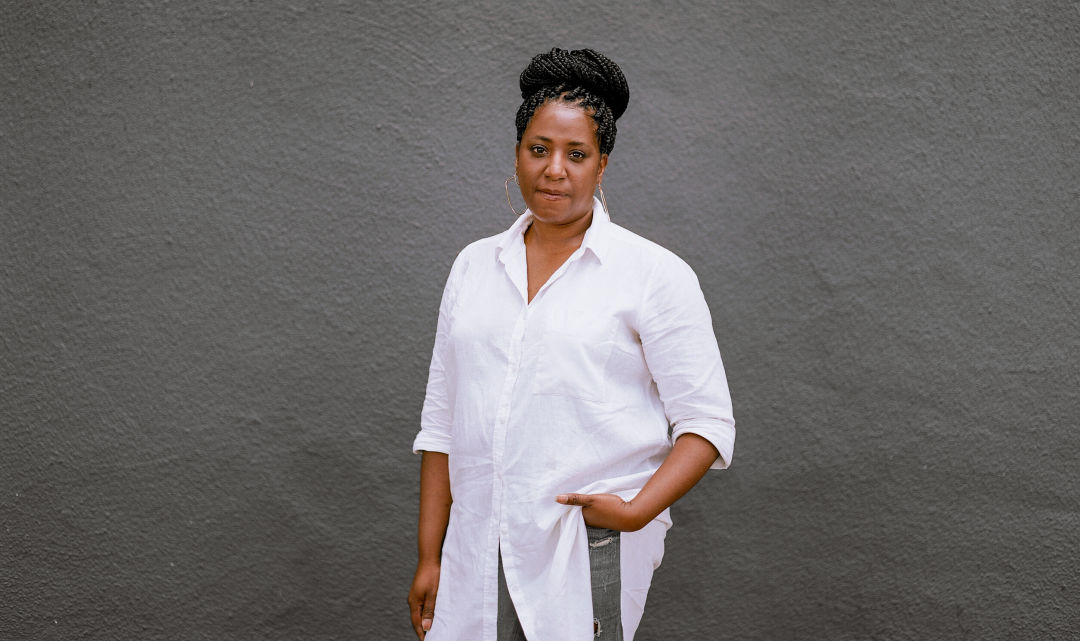Are You a Portland Company Committing to Working for Racial Justice?

“I need to know how to function in white culture because that’s the power system,” says Lori Caldwell, pictured. “For us, it’s required learning. For you, it’s an elective. You do not have to know anything about my culture to be successful, or to survive.”
Image: Courtesy Lori Caldwell
Lori Caldwell knows business. She’s been a personal stylist in Washington, DC, dressing clients like Chelsea Clinton and Madeleine Albright, she’s taught English in six countries, she’s mastered retail management, and she helmed one of Portland’s loveliest leather lines, Minnie + George. In all that, both being an employee in predominantly white spaces and running a business, she’s seen countless examples of what brands should and shouldn’t do to support BlPOC employees and community. She recalls working for a well-known Portland brand as the only Black employee, with no HR rep to turn to when one of her coworkers repeatedly told racist jokes, and being a Black designer constantly having to justify the pricing of her luxe goods in ways her white counterparts didn’t. Now, however, she sees real possibility.
“Monday morning I woke up, like, cheery,” she says. “And the reason I woke up cheery is I thought maybe this is good. Maybe the pandemic, the economic crisis, having a crazy man in the office as president, having all this going on is going to make us rebuild a better world.” Caldwell recalls being a senior in high school when the Rodney King beating happened. “We’ve seen violence against black bodies. We can’t act like this is new. But what I think is, we’re all home—because a large population is unemployed or we work from home—so we can't run away from it now. You get to go protest Monday, Tuesday, Wednesday, Thursday because you don’t have anywhere else to be. And so now you can have some useful purpose and now this thing is sustained. And maybe through being a sustained thing it’ll become an actual thing that we put some action towards and create real meaningful change.”
In light of many recent company pledges to do better when it comes to diversity, equity, inclusion, and antiracism, Caldwell took to Instagram, using her years of experience to offer advice to brands on how they can turn their public statements into public action. We followed up with her to find out more.
1. Create a social mission statement.
“This is something every business, no matter how large or small, can do. So often, when things happen we are reactive. We want to say or do something, but don’t know exactly how. A social mission statement helps you clearly articulate your values and your commitment to those values in your work before, during, and after things happen in our society. You get to have a proactive foundation from which to stand.
“For me it was a way of formalizing what I was actually already doing the five years I had Minnie & George. My business statement was my social mission statement, always, they were always linked. And my purpose was always to say, and partly because I grew up in the Black church. The Black church has always been not only a religious space but also a social justice space. You’re taught from the time that you can understand language that your job in this world is to use whatever platform you have to make the world better. Tha}ts just constant, even when it’s not said it’s said.”
2. Don’t just say you’ve done unintentional harm.
“Unintentional or intentional, if you’ve done harm you’ve done harm. And you just need to own up to that. Putting out that statement is really a way of backing away from responsibility to some degree. It’s saying, ‘Oh, I didn’t know that, so please don’t be so mad at me.’ Why are you saying that? Are you saying that for my benefit, or are you saying it for yours? Because in an apology, you should be saying something for my benefit, not to cover your ass. Don’t say, ‘I didn't know’—say, ‘I haven’t done the work yet.’ Take responsibility that you haven’t done the work because the information and the knowledge is out there in abundance. All I want to hear is, ‘I’m sorry, I haven’t done the work, and here’s how I’m going to take some actionable steps to never repeat that.”
3. Put in the effort to understand.
“For a person of color—Black people specifically since I’m a Black person—from the time you are conscious, you have to study white culture for your survival. To put food in your mouth, clothes on your back, have a place to stay, just for basics. I need to know how to function in white culture because that’s the power system. And I’m also bombarded by it because all of the advertising. Growing up, I knew more about your hair care than my own. When’s the last time you saw an ad on TV for African American hair products? For us, it’s required learning. For you, it’s an elective. You do not have to know anything about my culture to be successful, or to survive.”
4. Build an infrastructure that reflects your goals.
“Once, you’ve created your foundation, it’s time to build a business structure that reflects it. A business has finance, marketing, production, customer service, and so on. You can make social equity part of your business model, too. Decide where you want to contribute, how to serve your community, and be vigilant about truly inclusive and diverse hiring practices. It’s not enough to hire a POC model. Representation is great, but ask yourself, ‘Does anyone behind the camera look like that model in my company?’ Consider creating a social equity position, preferably for a person of color, who is better equipped to catch any blind spots you may have, even if you have someone who only comes in twice a year as a consultant. [This kind of consulting is another one of Caldwell’s many hats: reach her at [email protected].] Even if you do all that work on your own, I guarantee you’re going have some huge blind spots that you don’t know about. If you’re an all-white company and there are no other voices, you’re going to stay in your echo chamber, no matter what.”
5. Did you listen? Tell us what you learned.
“If you were quiet for a week because you were trying to amplify voices and listen, my question is: Did you really listen? And if you listened, what did you learn? And if you learned something, now you can go ahead and unmute yourself and start sharing what you learned loudly, repeatedly, and to everyone you know. Even if that puts you in situations where you’re uncomfortable. And then the last step is, now that we’ve amplified those voices, now let’s incorporate them. So now the question becomes how do you take all of those things? I’ve listened, I’ve learned, I’ve shared. How are you now taking an actionable step? Point to incorporate what you’ve learned and share in your life, in your work, in your community, in your home, and in your family."
6. Look for role models.
“Model yourself on companies who are doing the work and have been doing the work. When I was starting a company, I didn’t have resources. I didn’t have a business degree. I didn’t know what I was doing. So what did I do? I started looking at how successful companies ran their businesses. Going on their websites, trying to figure out how you set it up, that’s how I learned. Ben and Jerry's—if you go on their website they literally have a section that says values. What they do, how they’re doing it, and they release a social equity responsibility report, so I can literally hold them accountable and see their numbers.”
7. Be transparent and give accountability updates.
“Give an account of how you are fulfilling your commitment biannually. A SER (social equity report) is a great tool to review and share your contribution, and it can help make clear areas where you still have room to grow and improve. Pick three things. For example: I want to be focused on racial equity. I want to be focused on environmental practice. I want to be focused on rights for the transgender community. Those three things are three things I’m super passionate about. So, on a macro level I’m going to be donating to all those groups. And then ask yourself, what you can do on the micro level right in your community. Those are your action steps. Then, give yourself a deadline and a timeline, so that you measure all of these things and how successful you are. That’s your social equity mobility report that you’re going to put out. These were their goals—here’s where we met them. Maybe you went even further than you thought you were going to go. Or, here’s where we fell short. Here’s how much money we donated. Here’s how much time we gave. Put that down on paper so you can review it and you can give yourself some actionable goals. Then you start that process all over again.”




